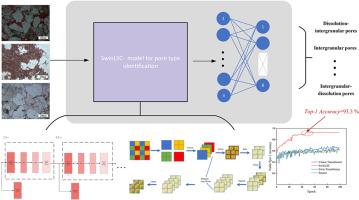Microscopic pore combination type identification of tight sandstone reservoir based on improved swin transformer architecture
IF 3.6
引用次数: 0
Abstract
Tight sandstone reservoirs differ fundamentally from conventional medium to high permeability reservoirs due to their complex and heterogeneous microscopic pore structures. This complexity poses significant challenges for accurate reservoir characterization and often results in suboptimal development performance. The specific configuration of microporosity combinations plays a decisive role in determining the storage and seepage capacities of tight sandstone reservoirs. Therefore, the precise identification of microporosity combination types is essential for improving both reservoir evaluation accuracy and development effectiveness. However, traditional computer vision models exhibit limitations in capturing fine-grained textures and spatial relationships among microscopic pores with complex morphologies, leading to inadequate generalization capabilities. To address these issues, this study proposes an enhanced Swin Transformer-based neural network architecture, termed SwinLSC (Swin Transformer with Linformer and Self-Adaptive Channel Attention). The model incorporates a global-local attention mechanism and is trained on image datasets of cast thin sections from tight sandstone reservoirs in the Yanchang Oilfield. To evaluate model performance, Top-1 Accuracy, Loss, and Recall metrics were employed, and the SwinLSC model was benchmarked against three mainstream architectures: Swin Transformer, Vision Transformer (ViT), and ResNet. Experimental results demonstrate that SwinLSC achieves a prediction accuracy of 93.3 %, significantly outperforming the comparative models. These findings indicate that the SwinLSC model effectively addresses the generalization deficiencies of conventional approaches in recognizing microstructural features in cast thin section imagery. Consequently, it offers a robust and accurate solution for microporosity type identification, thereby providing reliable technical support for the efficient exploration and development of tight sandstone reservoirs.

基于改进swin变压器构型的致密砂岩储层微观孔隙组合类型识别
致密砂岩储层微观孔隙结构复杂、非均质,与常规的中高渗储层有着根本的区别。这种复杂性给准确的油藏描述带来了巨大的挑战,并经常导致开发性能不理想。微孔组合的具体形态对致密砂岩储层的储集和渗流能力起决定性作用。因此,准确识别微孔隙组合类型对提高储层评价精度和开发效果至关重要。然而,传统的计算机视觉模型在捕获具有复杂形态的微观孔隙之间的细粒度纹理和空间关系方面存在局限性,导致泛化能力不足。为了解决这些问题,本研究提出了一种基于Swin变压器的增强神经网络架构,称为SwinLSC(带有Linformer和自适应信道注意的Swin变压器)。该模型结合了全局-局部关注机制,并以延长油田致密砂岩储层铸体薄片图像数据集为训练对象。为了评估模型的性能,采用了Top-1 Accuracy、Loss和Recall指标,并且对SwinLSC模型进行了三种主流架构的基准测试:Swin Transformer、Vision Transformer (ViT)和ResNet。实验结果表明,该方法的预测精度达到93.3%,显著优于对比模型。这些发现表明,SwinLSC模型有效地解决了传统方法在识别铸型薄片图像显微结构特征方面的泛化缺陷。从而为致密砂岩储层的高效勘探开发提供了可靠、准确的微孔类型识别解决方案,为致密砂岩储层的高效勘探开发提供了可靠的技术支持。
本文章由计算机程序翻译,如有差异,请以英文原文为准。
求助全文
约1分钟内获得全文
求助全文

 求助内容:
求助内容: 应助结果提醒方式:
应助结果提醒方式:


